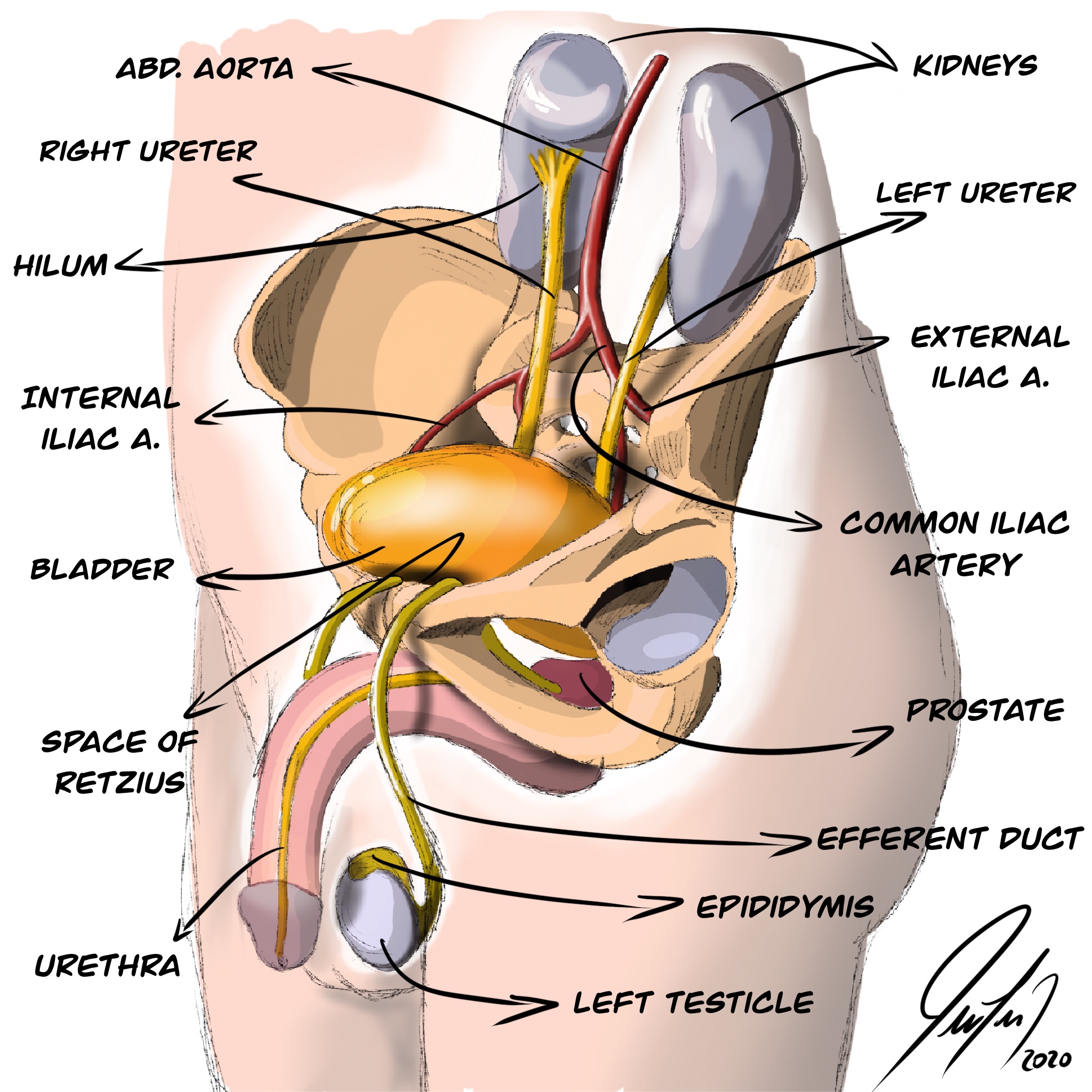[1]
Abelson B, Sun D, Que L, Nebel RA, Baker D, Popiel P, Amundsen CL, Chai T, Close C, DiSanto M, Fraser MO, Kielb SJ, Kuchel G, Mueller ER, Palmer MH, Parker-Autry C, Wolfe AJ, Damaser MS. Sex differences in lower urinary tract biology and physiology. Biology of sex differences. 2018 Oct 22:9(1):45. doi: 10.1186/s13293-018-0204-8. Epub 2018 Oct 22
[PubMed PMID: 30343668]
[2]
Jung J, Ahn HK, Huh Y. Clinical and functional anatomy of the urethral sphincter. International neurourology journal. 2012 Sep:16(3):102-6. doi: 10.5213/inj.2012.16.3.102. Epub 2012 Sep 30
[PubMed PMID: 23094214]
[3]
Little MH, Kumar SV, Forbes T. Recapitulating kidney development: Progress and challenges. Seminars in cell & developmental biology. 2019 Jul:91():153-168. doi: 10.1016/j.semcdb.2018.08.015. Epub 2018 Sep 20
[PubMed PMID: 30184476]
[4]
Tanaka ST, Ishii K, Demarco RT, Pope JC 4th, Brock JW 3rd, Hayward SW. Endodermal origin of bladder trigone inferred from mesenchymal-epithelial interaction. The Journal of urology. 2010 Jan:183(1):386-91. doi: 10.1016/j.juro.2009.08.107. Epub
[PubMed PMID: 19914648]
[5]
Makiyan Z. Studies of gonadal sex differentiation. Organogenesis. 2016 Jan 2:12(1):42-51. doi: 10.1080/15476278.2016.1145318. Epub 2016 Mar 7
[PubMed PMID: 26950283]
[6]
Joseph A, Yao H, Hinton BT. Development and morphogenesis of the Wolffian/epididymal duct, more twists and turns. Developmental biology. 2009 Jan 1:325(1):6-14. doi: 10.1016/j.ydbio.2008.10.012. Epub 2008 Nov 1
[PubMed PMID: 18992735]
[7]
Archambeault DR, Tomaszewski J, Joseph A, Hinton BT, Yao HH. Epithelial-mesenchymal crosstalk in Wolffian duct and fetal testis cord development. Genesis (New York, N.Y. : 2000). 2009 Jan:47(1):40-8. doi: 10.1002/dvg.20453. Epub
[PubMed PMID: 18979542]
[8]
Hutson JM, Nation T, Balic A, Southwell BR. The role of the gubernaculum in the descent and undescent of the testis. Therapeutic advances in urology. 2009 Jun:1(2):115-21. doi: 10.1177/1756287209105266. Epub
[PubMed PMID: 21789060]
[9]
Asensio JA, Forno W, Roldan G, Petrone P, Rojo E, Tillou A, Murray JA, Feliciano DV. Abdominal vascular injuries: injuries to the aorta. The Surgical clinics of North America. 2001 Dec:81(6):1395-416, xiii-xiv
[PubMed PMID: 11766182]
[10]
Li X, Yin Y, Sheng X, Han X, Sun L, Lu C, Wang X. Distribution pattern of lymph node metastases and its implication in individualized radiotherapeutic clinical target volume delineation of regional lymph nodes in patients with stage IA to IIA cervical cancer. Radiation oncology (London, England). 2015 Feb 15:10():40. doi: 10.1186/s13014-015-0352-5. Epub 2015 Feb 15
[PubMed PMID: 25886535]
[11]
Campi R, Minervini A, Mari A, Hatzichristodoulou G, Sessa F, Lapini A, Sessa M, Gschwend JE, Serni S, Roscigno M, Carini M. Anatomical templates of lymph node dissection for upper tract urothelial carcinoma: a systematic review of the literature. Expert review of anticancer therapy. 2017 Mar:17(3):235-246. doi: 10.1080/14737140.2017.1285232. Epub 2017 Feb 6
[PubMed PMID: 28103449]
Level 1 (high-level) evidence
[12]
Patel AP. Anatomy and physiology of chronic scrotal pain. Translational andrology and urology. 2017 May:6(Suppl 1):S51-S56. doi: 10.21037/tau.2017.05.32. Epub
[PubMed PMID: 28725619]
[13]
Dean RC, Lue TF. Physiology of penile erection and pathophysiology of erectile dysfunction. The Urologic clinics of North America. 2005 Nov:32(4):379-95, v
[PubMed PMID: 16291031]
[14]
Revenig L, Leung A, Hsiao W. Ejaculatory physiology and pathophysiology: assessment and treatment in male infertility. Translational andrology and urology. 2014 Mar:3(1):41-9. doi: 10.3978/j.issn.2223-4683.2014.02.02. Epub
[PubMed PMID: 26816751]
[15]
Eid S, Iwanaga J, Loukas M, Oskouian RJ, Tubbs RS. Pelvic Kidney: A Review of the Literature. Cureus. 2018 Jun 9:10(6):e2775. doi: 10.7759/cureus.2775. Epub 2018 Jun 9
[PubMed PMID: 30109168]
[16]
Park JC, Citrin DE, Agarwal PK, Apolo AB. Multimodal management of muscle-invasive bladder cancer. Current problems in cancer. 2014 May-Jun:38(3):80-108. doi: 10.1016/j.currproblcancer.2014.06.001. Epub 2014 Jun 23
[PubMed PMID: 25087173]
[17]
Lokeshwar SD, Harper BT, Webb E, Jordan A, Dykes TA, Neal DE Jr, Terris MK, Klaassen Z. Epidemiology and treatment modalities for the management of benign prostatic hyperplasia. Translational andrology and urology. 2019 Oct:8(5):529-539. doi: 10.21037/tau.2019.10.01. Epub
[PubMed PMID: 31807429]
[18]
Gurney JK, McGlynn KA, Stanley J, Merriman T, Signal V, Shaw C, Edwards R, Richiardi L, Hutson J, Sarfati D. Risk factors for cryptorchidism. Nature reviews. Urology. 2017 Sep:14(9):534-548. doi: 10.1038/nrurol.2017.90. Epub 2017 Jun 27
[PubMed PMID: 28654092]
[19]
Bouty A, Ayers KL, Pask A, Heloury Y, Sinclair AH. The Genetic and Environmental Factors Underlying Hypospadias. Sexual development : genetics, molecular biology, evolution, endocrinology, embryology, and pathology of sex determination and differentiation. 2015:9(5):239-259. doi: 10.1159/000441988. Epub 2015 Nov 28
[PubMed PMID: 26613581]
[20]
Jordan SJ, Aaron KJ, Schwebke JR, Van Der Pol BJ, Hook EW 3rd. Defining the Urethritis Syndrome in Men Using Patient Reported Symptoms. Sexually transmitted diseases. 2018 Jul:45(7):e40-e42. doi: 10.1097/OLQ.0000000000000790. Epub
[PubMed PMID: 29465655]

